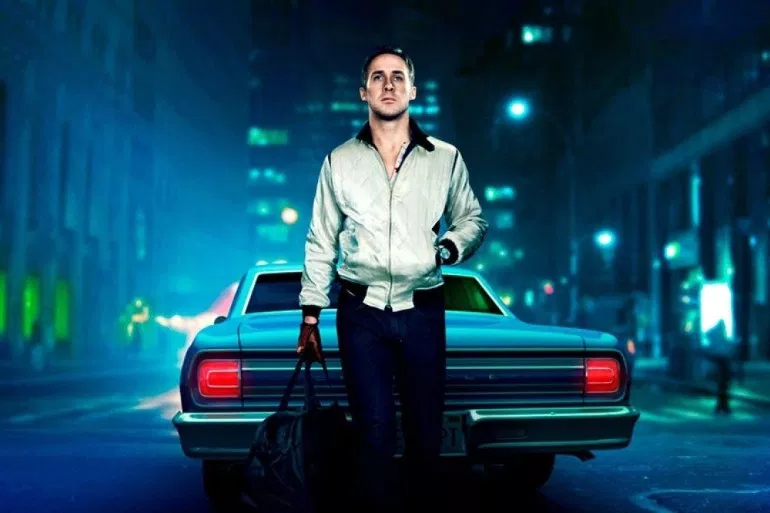“There’s a hundred thousand streets in the city. You don’t need to know the route. You give me a time and a place. I give you a five-minute window….”
With two thieves as his passengers, The Driver threads the streets of downtown Los Angeles, outrunning and evading the police patrol cars and helicopter with ease. It’s a battle of wits in petrol-powered steel beasts, and The Driver never loses.
Continuing FilmEra’s Horsepower Month theme, we bring you the 2011 cult classic: Drive. The movie caught everyone’s attention soon after its release with its stylish presentation, gorgeous cinematography, and its immersive blend of serene and brooding atmosphere. That atmosphere is strengthened by a moody soundtrack by Cliff Martinez and the incorporation of Synthwave songs (which at the time reinvigorated the genre with the film’s popularity). Since then, Drive has become a frequent guest on many a cinephile’s list of recommended films or personal favorites.
Drive is on my list as well, and let me tell you why.
Ryan Gosling is The Driver. He is a car mechanic and part-time stunt driver by day, but after the sun sets, he can be your getaway lifeline for five minutes. After he lends a hand to his neighbor Irene (Carey Mulligan) when her car breaks down, he opens up a friendship with the mother and son in his isolated life. But The Driver cannot anticipate he’s about to be swept up in something bigger than all of them when Irene’s husband, Standard Gabriel (Oscar Isaacs), is released from prison.
Gosling’s stoic presence is the pillar that holds up this movie (the same screen presence made him Denis Villeneuve’s first choice to play Blade Runner 2049’s lead). Drive is a slow burner that nurses its emotions, and Gosling’s silent intensity allows those emotions to brew as long as the film wants while never ceasing to engage the audience. People often hail Gosling and Emma Stone as the best on-screen couple (in La La Land), but frankly, I disagree. While those two did have decent chemistry together, it simply could not hold a candle to the relationship between The Driver and Irene. Gosling’s tranquil energy bounced off Mulligan well. Not only could Mulligan easily match Gosling’s subdued performance with her warmth, but the two were also comfortable in each other’s silence, and they quietly relished each other’s company. This type of on-screen romance is rare.
However, there is also a dark side to The Driver. Under his stony veneer is an unexploded rage. Nothing fazes The Driver, but when people threaten what he holds dear, his usual mask-like expression is barely able to contain the bubbling up white-hot anger. Whenever The Driver gets violent, the film’s darkly hypnotic soundtrack then appeals to our primal bloodlust and invites us to revel in his brutality. Drive can be sinister and alluring.
The action scenes in Drive are just as raw and abrupt as the temperament of the Driver. The film does not employ any fancy choreography; instead, it relies on sheer force to achieve a visceral experience. Encounters are bloody and brutal, and they end as swiftly as they begin. The same philosophy extends to the car chases. The car chases in Drive are an intense experience without any of the fancy car stunts featured in action series such as Fast and Furious. The first thing the audience notices in chase scenes is how majestic the engine roars are. The excellent sound design infuses the cars with a great sense of power, which many blockbusters fail to match. The cars themselves possess a weighty physicality making the chases more tangible and thus more engaging than most other car-related movies.
Drive has a small cast, but nearly every performance the cast gives is memorable; there are many highlights besides Gosling and Mulligan. Bryan Cranston once again proves himself a chameleon who can disappear into any role, and this time as the closest thing to a friend our lone-wolf protagonist has The Driver’s amiable employer Shannon. Cranston sells the “has-been small-time businessman trying to do better than survive” character to me. His interaction with his two gang bosses is an impressively convincing mixture of friendly banter, fear, and pleading. One of the two mob bosses is Ron Perlman, playing a Jewish gangster with an easily bruised pride. Albert Brooks’s new spin on mobster archetype as a reluctant mob boss who laments the violence in his trade is also positively refreshing.
Back when I first watched Drive, I was a high school senior with very little knowledge about cinema, yet I was in awe of it. Over the years, my love for Drive has deepened as I learned more about the art form, and now I can identify more clearly each component that made me feel what I felt. Go watch Drive if you haven’t, and I am confident the striking visuals—the beautifully lit nighttime scenes are particularly fantastic—excellent performances by the cast, and the overflowing atmosphere will put you under its spell. If you have watched this film, why not put it on again when it’s dark outside if only to listen to Nightcall again?


